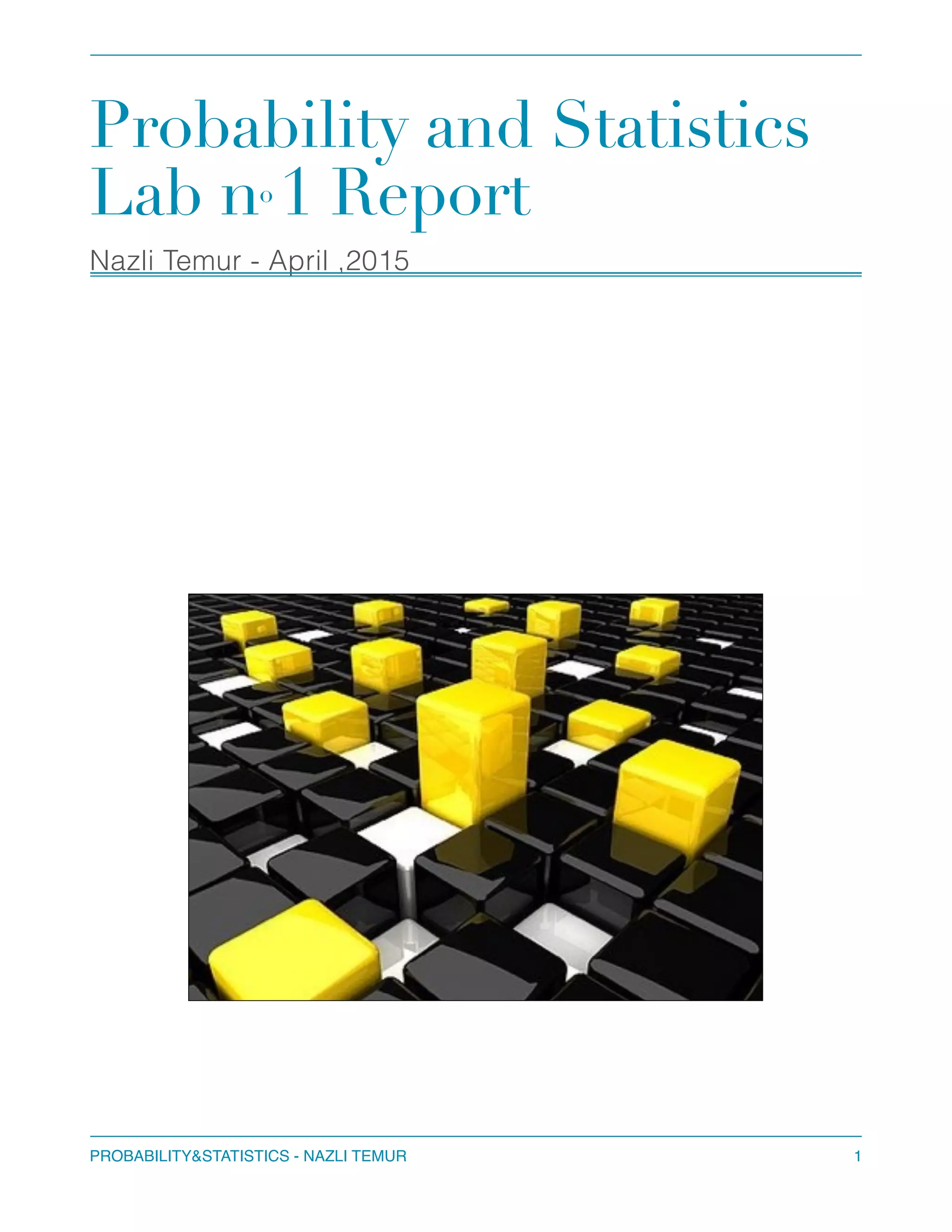1. The document describes exercises from a probability and statistics lab report, including generating random vectors, estimating distributions, and assessing hypotheses.
2. For the first exercise, random vectors were generated from uniform, normal, and exponential distributions and their histograms, CDFs, and boxplots were represented. Bin sizes were also calculated.
3. Subsequent exercises involved comparing mean and variance, assessing dependence between random variables, modeling loss event data, and applying the central limit theorem.

![Introduction
This lab includes 5 main exercises that should be completed by the help of R Tool.
I achived to complete all the exercises except 5th one and this report includes a small
brief as per exercises along with R codes&outcomes.
Exercise 1
1.1 Generate 3 random vectors of size 10000 from different distributions .
• A uniform distribution between 0 and 1.
unif <-runif(10000,0.0,1.0)
• AnormaldistributionN(0,10)
norm<-rnorm(10000,0,sqrt(10))
• A exponential distribution of parameter λ = 2
rexp(10000,2)
a) What is the number of bins to be used to represent the corresponding
histograms according to Sturge’s rule?
Technically, Sturges’ rule is a number-of-bins rule rather than a bin-width rule.
> number_of_bin=log(10000,base=2)+1
> number_of_bin
[1] 14.28771
PROBABILITY&STATISTICS - NAZLI TEMUR 2
n=1+log
2
N](https://image.slidesharecdn.com/probabilitystatisticsreport-160623223057/75/Using-R-Tool-for-Probability-and-Statistics-2-2048.jpg)
![b) What is the bin size according to the Normal Reference rule?
For Uniform : ((24*(sd(unif)^2)*sqrt(pi))/10000)^(1/3)
0.0706738
For Normal : ((24*(sd(norm)^2)*sqrt(pi))/10000)^(1/3)
0.3470349
For Exponantial : ((24*(sd(exp)^2)*sqrt(pi))/10000)^(1/3)
0.1013582
c) What is the number of bins for each sample vector you have generated
according to the Normal Reference Rule ?
For Uniform :
> unif_n=NULL
> unif_max=length(unif)
> unif_min=0
> unif_n=(unif_max-unif_min)/unif_h
> unit_n [1] 141495.2
PROBABILITY&STATISTICS - NAZLI TEMUR 3](https://image.slidesharecdn.com/probabilitystatisticsreport-160623223057/75/Using-R-Tool-for-Probability-and-Statistics-3-2048.jpg)
![For Normal :
> norm_n=NULL //number
> norm_max=length(norm) // number of elements
> norm_max
[1] 10000
> norm_min=0
> norm_n=(norm_max-norm_min)/norm_h
> norm_n //number of elements divided by width of bin equally gives number of bin
[1] 28815.54
For Exponantial :
> exp_n=NULL
> exp_max=length(exp)
> exp_min=0
> exp_n=(exp_max-exp_min)/exp_h
> exp_n
[1] 98660.04
PROBABILITY&STATISTICS - NAZLI TEMUR 4](https://image.slidesharecdn.com/probabilitystatisticsreport-160623223057/75/Using-R-Tool-for-Probability-and-Statistics-4-2048.jpg)


![Exercise 2
2. E[1/X] vs. 1/E[X]
Let us consider the family of uniform distributions in the interval [100 − v, 100 + v] for v > 0
2.1. What are the mean/variance of the family?
x=[a,b] //a =100-v b=100+v
E=[a+b]/2 //mean
V= [b-a]^2/12 //variance
E=(100+v-(100-v))/2 =100 it means the mean is not depend the variance of this uniform
distribution of interval.
V=((100+v) -(100-v))^2 /12 =(2v)^2/12 = v^2/3 which means, the variance is impacted
exponentially depend on the v value.
2.2. For each v ∈ {1, 2, . . . 30}, draw a random vector of size 1000, compute its empirical
variance v[X] as well as E[1/X] (simply mean(1/x) in R). Plot the pairs (E[1/X] − 1/E[X],
> for(v in seq(1,30,by=1))
+ { E=(100-v)+(100+v)/2
+ V=((100+v)-(100-v))^2/12
+ Vector_x<-rnorm(1000,E,V)
+ }
> for(v in seq(1,30,by=1))
+ { E=(100-v)+(100+v)/2
PROBABILITY&STATISTICS - NAZLI TEMUR 7](https://image.slidesharecdn.com/probabilitystatisticsreport-160623223057/75/Using-R-Tool-for-Probability-and-Statistics-7-2048.jpg)

![For Adjusment :
> min_x=quantile(X,0.1)
> max_x=quantile(X,0.9)
> min_y=quantile(Y,0.1)
> max_y=quantile(Y,0.9)
> X2<-X[X>min_x&X<max_x]
> Y2<-Y[Y>min_y&Y<max_y]
> plot(X2,Y2,main="Adjusted Scatter Plot")
> qqplot(X2,Y2,main="Adjusted QQ Plot")
>
3.2. Let Z = log(X) + 5. Plot the qqplot and the scatterplot of X and Z. Comment the results
PROBABILITY&STATISTICS - NAZLI TEMUR 9](https://image.slidesharecdn.com/probabilitystatisticsreport-160623223057/75/Using-R-Tool-for-Probability-and-Statistics-9-2048.jpg)

![Exercise 4
4. Loss Events
4.1 Data Cleaning
myfile=scan("~/Desktop/LAB/147.32.125.132.loss.txt")
Read 3439 items
min=quantile(myfile,0.1)
max=quantile(myfile,0.9)
X<-myfile
X2<-X[X>min&X<max]
X2
boxplot(X,X2)
myfile2=scan("~/Desktop/LAB/195.204.26.25.loss.txt")
Read 16091 items
min2=quantile(myfile2,0.1)
max2=quantile(myfile2,0.9)
Y<-myfile2
Y2<-Y[Y>min&Y<max]
Y2
boxplot(Y,Y2)
PROBABILITY&STATISTICS - NAZLI TEMUR 11](https://image.slidesharecdn.com/probabilitystatisticsreport-160623223057/75/Using-R-Tool-for-Probability-and-Statistics-11-2048.jpg)
![4.2 Assessing the exponential hypothesis
4.2.1. For each of the 2 connections (the cleaned versions obtained from the previous
question), estimate the parameter of the exponential distribution that should model it.
First File
> myfile=scan("~/Desktop/LAB/147.32.125.132.loss.txt")
> Read 3439 items
> min=quantile(myfile,0.1)
> max=quantile(myfile,0.9)
> X<-myfile
> X2<-X[X>min&X<max]
> Mean_vector_x=NULL
> for(V in seq(1,1000,by=1)) {
+ x<-rnorm(1000,mean(X2),sqrt(var(X2)))
+ y<-sample(x,10)
+ Mean_vector_x<-c(Mean_vector_x,mean(y))
+ }
+ > hist(Mean_vector_x,main=“Sample Means")
+ > plot(Mean_vector_x,main=“Sample Means”)
Second File
PROBABILITY&STATISTICS - NAZLI TEMUR 12](https://image.slidesharecdn.com/probabilitystatisticsreport-160623223057/75/Using-R-Tool-for-Probability-and-Statistics-12-2048.jpg)
![Second File
> myfile2=scan("~/Desktop/LAB/195.204.26.25.loss.txt")
Read 16091 items
> min2=quantile(myfile2,0.1)
> max2=quantile(myfile2,0.9)
> Y<-myfile2
> Y2<-Y[Y>min&Y<max]
> Mean_vector_y=NULL
> for(V in seq(1,1000,by=1)) {
+ x<-rnorm(1000,mean(Y2),sqrt(var(Y2)))
+ y<-sample(x,10)
+ Mean_vector_y<-c(Mean_vector_y,mean(y))
+ }
+ > hist(Mean_vector_y,main=“Sample Means of Second File ")
+ > plot(Mean_vector_y,main=“Sample Means of Second File ")
PROBABILITY&STATISTICS - NAZLI TEMUR 13](https://image.slidesharecdn.com/probabilitystatisticsreport-160623223057/75/Using-R-Tool-for-Probability-and-Statistics-13-2048.jpg)

